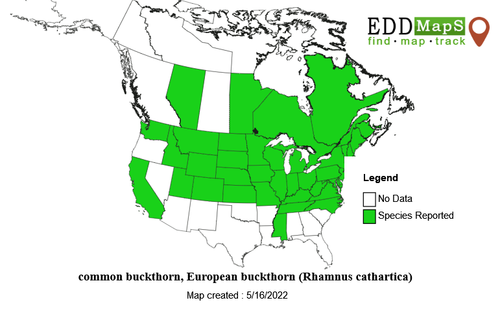Rhamnus cathartica (Common Buckthorn)
Rhamnus cathartica also known as Common Buckthorn, Purging buckthorn, European buckthorn, or buckthorn is a plant native to calcareous soils throughout England, into Scandaninavia and across Russia into western Asia, as well as being found as far south as Morocco and Algeria.[1] Buckthorn was introduced to the United States as early as the 1800s as an ornamental shrub by, and is now common across many of the lower 48 states as an invasive species.[2]

| |
| Kingdom: | Plantae |
|---|---|
| Phylum: | Magnoliophyta |
| Class: | Magnoliopsida |
| Order: | Rosales |
| Family: | Rhamnaceae |
| Genus: | Rhamnus L |
| Species: | R. cathartica L. |
| Source: United States Department of Agriculture[3] | |
Description
Rhamnus cathartica is a medium to large sized woody plant..[4] Twigs end in sharp spines, and are usually dark and unlined.[4] Leaves are elliptic, hairless, and finetoothed, usually 1 1/2" to 2".[4] Plant usually flowers from May to June, small, greenish, clustered blooms. Fruits are produced in numerous drupes, with berries which turn from green to black as they ripen.[2] Although leaves usually exhibit opposite growth form, older growth may display alternate.[4]
Ecology
Buckthorn is a relatively fast-growing species, able to grow both in shady and open conditions.[2] Germination occurs in the autumn and spring in Great Britain, and mid- to late summer in some areas of the US, such as Minnesota.[2] R. cathartica produces fruit, at a rate which is often called aggressive, aiding in a high reproduction rate.[2] Buckthorn can grow in a range of soil types, from wetlands to drier oak forests.[2]
R. cathartica is also a possible host for oat crown rust, a disease which affects oat seed farming, making it of interest for United States agriculture.[1]
Extremely similar to the relationship between monarch butterflies and plants of the Asclepiadaceae (milkweed) family, common buckthorn acts as an important host plant to the brimstone butterfly (Gonepteryx rhamni) in its native ranges in Europe.[5]
Allelopathy
R. cathartica contains a number of secondary compounds, the primary one of concern being emodin.[2]
Impact as an Invasive Species

Uses
R. cathartica is a purgative, meaning that it may cause stomach cramps through toxins, especially emodin, present in its berries and shoots.
References
- ↑ 1.0 1.1 O. W. Archibold, D. Brooks, L. Delanoy, "An Investigation of the Invasive Shrub European Buckthorn Rhamnus cathartica L., near Saskatoon, Saskatchewan", The Canadian Field-Naturalist. October 1997. Retrieved 5/16/2022.
- ↑ 2.0 2.1 2.2 2.3 2.4 2.5 2.6 Kathleen S. Knight, Jessica S. Kurylo, Anton G. Endress, J. Ryan Stewart, Peter B. Reich, "Ecology and ecosystem impacts of common buckthorn (Rhamnus cathartica): a review", Biological Invasions (2007) 9:925-937. 13 February 2007. doi: 10.1007/s10530-007-9091-3. Retrieved 5/16/2022.
- ↑ "Rhamnus Cathartica Plant Profile", USDA "USDA Natural Resource Conservation Service", USDA, n.d.. Retrieved 5/16/2022.
- ↑ 4.0 4.1 4.2 4.3 George A. Petrides, "The Peterson Field Guide Series: A Field Guide to Trees and Shrubs", Boston: Houghton Mifflin Company, 1986. ISBN: 0-395-17579 "
- ↑ David Gutiérrez, Chris D. Thomas, "Marginal range expansion in a host-limited butterfly species Gonepteryx rhamni" Ecological Entomology (2000) 25, 165-170. 25 December 2001. Retrieved 5/16/2022.